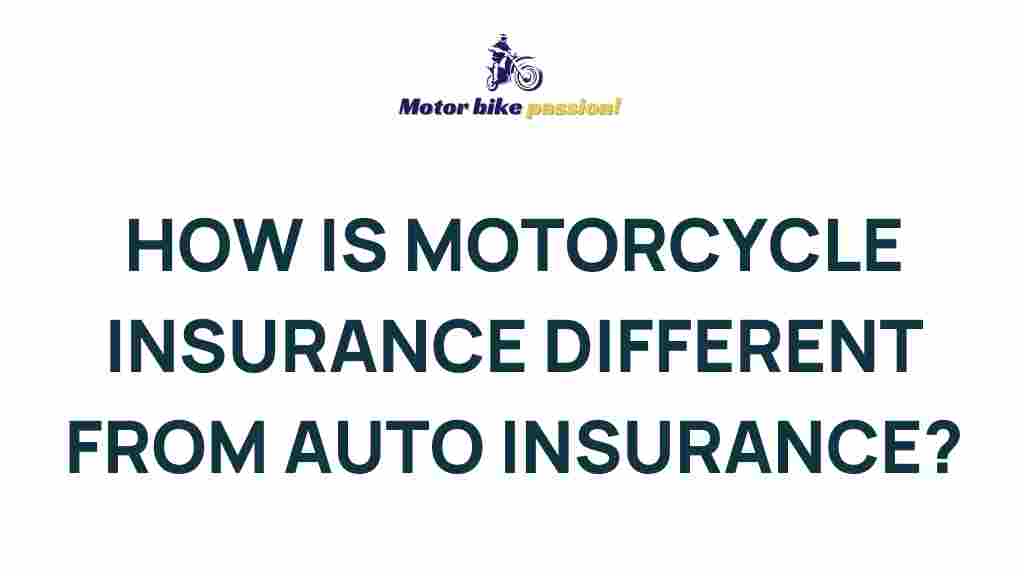Unraveling the Mysteries of Motorcycle Insurance vs. Auto Insurance
When it comes to protecting your ride, understanding the nuances between motorcycle insurance and auto insurance is essential. Whether you’re a seasoned biker or a new car owner, knowing the coverage differences, premium rates, liability aspects, and policy options can help you make informed decisions. In this comprehensive guide, we will delve into these topics and help you navigate the world of insurance.
Understanding the Basics of Motorcycle Insurance and Auto Insurance
Both motorcycle and auto insurance serve the same fundamental purpose: to provide financial protection against accidents, theft, and other unforeseen events. However, they differ significantly in terms of coverage, premium rates, and specific policy options.
Coverage Differences
Let’s break down the coverage differences between motorcycle insurance and auto insurance:
- Liability Coverage: Both types of insurance include liability coverage, which pays for damages to other people and their property if you are at fault in an accident. However, motorcycle liability limits may differ based on state laws.
- Comprehensive Coverage: This covers non-collision incidents such as theft, vandalism, or natural disasters. It is essential for both motorcycles and cars, but the rates may vary due to the different values of the vehicles.
- Collision Coverage: This pays for damage to your own vehicle after an accident, regardless of fault. Motorcycle collision coverage is often less expensive due to the lower cost of repairs compared to cars.
Premium Rates: What to Expect
Premium rates for motorcycle insurance and auto insurance can vary widely based on several factors:
- Vehicle Type: Motorcycles generally have lower insurance premiums compared to cars because they are less expensive to repair and replace.
- Rider Experience: For motorcycle insurance, your riding experience plays a crucial role. New riders may face higher premiums than experienced riders with clean records.
- Location: The area where you live can significantly impact your rates. Urban areas may lead to higher premiums due to increased risks of accidents and theft.
- Coverage Level: The amount of coverage you choose will affect your premiums. Higher limits and comprehensive options will increase your costs.
Policy Options for Motorcycle Insurance vs. Auto Insurance
Both motorcycle and auto insurance policies come with a variety of options. Understanding these can help you tailor your coverage to fit your needs:
- Basic Liability: This is the minimum required coverage in most states. It protects against damages to others but does not cover your vehicle.
- Full Coverage: This includes liability, collision, and comprehensive coverage, offering the most protection for both motorcycles and cars.
- Uninsured/Underinsured Motorist Coverage: This is crucial for both types of insurance. It protects you if you’re in an accident with someone who lacks sufficient insurance.
- Personal Injury Protection (PIP): This covers medical expenses for you and your passengers, regardless of who is at fault.
Step-by-Step Process to Choose the Right Insurance
Choosing the right insurance can feel overwhelming. Here’s a step-by-step process to simplify the decision:
- Assess Your Needs: Determine how often you ride or drive and the value of your vehicle. This will guide your coverage level.
- Research Providers: Look into various insurance companies that offer motorcycle and auto insurance. Read reviews and compare their offerings.
- Get Quotes: Request quotes from multiple insurers to compare premium rates. Make sure to provide the same coverage options for accuracy.
- Understand the Terms: Read the policy details carefully. Ensure you understand what is covered and what isn’t.
- Look for Discounts: Many insurers offer discounts for safe driving, bundling policies, or completing safety courses. Take advantage of these opportunities.
- Make Your Decision: After evaluating all factors, choose the policy that offers the best coverage for your needs at a reasonable rate.
Troubleshooting Common Insurance Issues
Even after selecting the right policy, you may encounter issues. Here are some common problems and how to troubleshoot them:
- High Premiums: If your premium seems too high, revisit your coverage options. Consider adjusting your deductible or exploring discounts.
- Claims Issues: If you experience delays or denials in claims, contact your insurer for clarification. Document all communications for reference.
- Understanding Policy Changes: Insurance companies may change terms annually. Review your policy each year to ensure it still meets your needs.
Conclusion: Making an Informed Choice
Understanding the differences between motorcycle insurance and auto insurance is vital for any vehicle owner. By familiarizing yourself with coverage differences, premium rates, and available policy options, you can make informed decisions that best protect your investment. Remember, whether you’re cruising on two wheels or four, adequate insurance is not just a legal requirement; it’s a critical shield against financial loss.
For more information on motorcycle insurance, check out this comprehensive guide. If you are considering auto insurance, don’t forget to review your options thoroughly and possibly consult an insurance expert.
This article is in the category SmartBuy and created by MotorBikePassion Team
